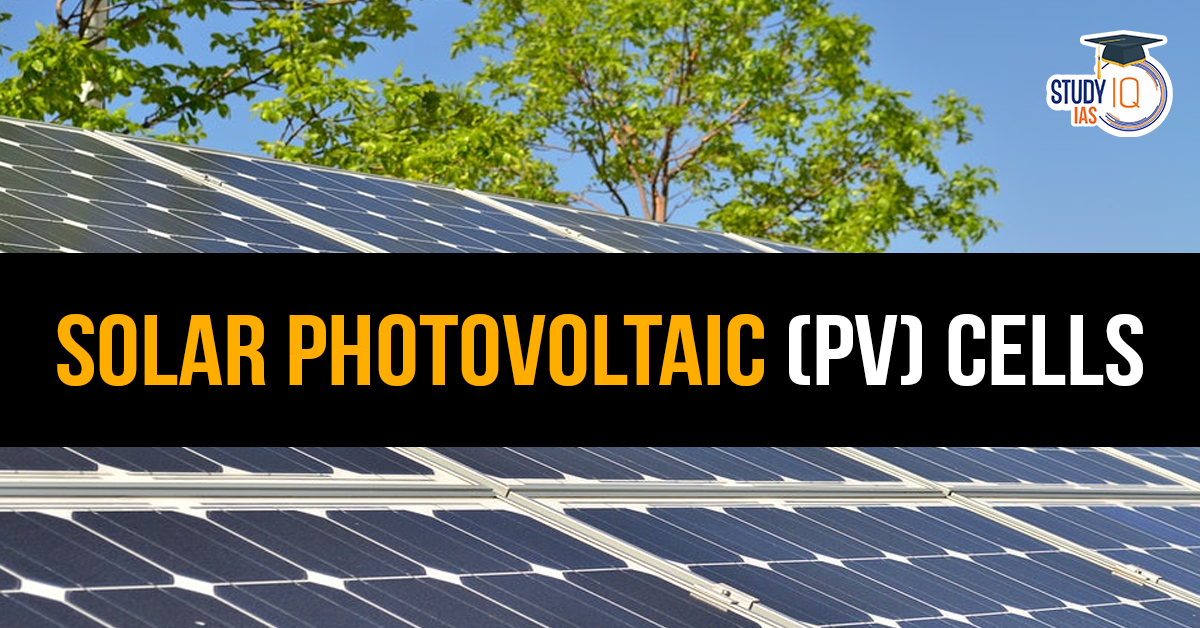Table of Contents
Context: India’s imports of solar photovoltaic (PV) cells from China jumped 141%.
About Solar Photovoltaic (PV) Cells
Photovoltaic (PV) cells, also known as solar cells, are the fundamental building blocks of solar panels, responsible for converting sunlight into electricity.
Key Components of a Photovoltaic Cell
- Semiconductor Layer: The primary material, often silicon, absorbs sunlight and generates electrical charge.
- Electrodes: These collect the electrical charge generated by the semiconductor material.
- Glass/Protective Layer: This protects the PV cell from environmental damage while allowing sunlight to pass through.
Types of Photovoltaic Cells
- Monocrystalline Solar Cells: Made from a single crystal structure, known for high efficiency.
- Polycrystalline Solar Cells: Made from silicon crystals that are melted and poured into moulds, less efficient than monocrystalline cells.
- Thin-Film Solar Cells: Made by depositing thin layers of photovoltaic material on a substrate, these are flexible but less efficient.
Why is India Import-Dependent for Photovoltaic Cells?
Lack of Domestic Manufacturing of Raw Materials
- India’s domestic capacity to produce the core components needed for photovoltaic cells is limited.
- Eg. Materials like wafers (used in PV cells) and ingots (a raw form of silicon) are not produced in sufficient quantities within India.
Cost-Competitiveness of Imported Cells
- Imported solar cells from countries like China are more cost-effective due to lower production costs.
- The cost of domestically produced solar cells is about 5 to 2 times higher than imported cells, even after considering Basic Customs Duty.
Lack of Advanced Manufacturing Technologies
- India lacks the advanced technologies and specialized production facilities required to manufacture high-efficiency photovoltaic cells at a competitive price.
Policy and Investment Gaps
- While the Indian government has launched various incentive schemes to promote solar energy, such as the PM KUSUM Scheme and the Atmanirbhar Bharat initiative, the domestic manufacturing sector has not been able to scale up quickly enough to meet demand.
| Solar Manufacturing Capacity in India |
|
How Are Solar Photovoltaic (PV) Cells Used in Solar Panels?
- PV cells are semiconductor devices (usually made of silicon) that convert sunlight directly into electricity via the photovoltaic effect.
- Working Principle: When sunlight (photons) strikes the PV cell, it excites electrons, creating an electric current if the photon energy exceeds the material’s band gap.
- Cell Construction: A typical silicon PV cell contains p-type and n-type semiconductor layers forming a p-n junction, which produces an electric potential when illuminated.
- Panel Assembly: Multiple PV cells are interconnected and encapsulated to form a solar panel/module. Several panels can be connected to make an array for higher electricity generation.
- Use in Panels: Solar panels are installed on rooftops or open fields to capture sunlight and supply electricity for homes, businesses, or the grid.
What is the Urban Heat Island Effect & How Might PV Installations Contribute?
- Contribution of PV Panels:
- PV modules absorb sunlight and convert only a part into electricity; the remainder is released as heat.
- Large-scale PV installations can raise local temperatures, exacerbating the heat island effect in densely populated urban settings.
Infrastructural and Climatic Constraints on PV Systems in Tropical & Low-Income Regions
Infrastructural Constraints
- Unreliable Grid: Weak electricity grids can’t always absorb or distribute generated solar power efficiently.
- High Initial Costs: Although PV module prices have fallen, the cost of supporting infrastructure (mounts, wiring, inverters, installation) remains high.
- Maintenance: Lack of trained technicians for installation, cleaning, and repairs.
- Storage Limitations: Battery storage for nighttime or cloudy days adds cost and complexity.
Climatic Constraints
- High Temperatures: PV modules operate less efficiently at high temperatures (common in tropics).
- Air Pollution & Dust: Pollution and dust reduce sunlight reaching the panels, lowering output (annual losses of 2–11% due to pollution, 3–4% due to soiling).
- Humidity & Rainfall: High humidity may affect module durability, and excessive rainfall can cause damage or disrupt connections.
- Sunlight Variability: Tropical regions may have intense, but also variable, solar insolation due to cloud cover or monsoons.
|
Major Solar Adoption Initiatives |
||
| Scheme / Mechanism | Focus Area | Incentives/Target |
| Surya Ghar: Muft Bijli Yojana | Rooftop residential solar | ↑1 Cr homes, 300 units/month, ₹78 k subsidy |
| PM-KUSUM Scheme (Pradhan Mantri Kisan Urja Suraksha evam Utthaan Mahabhiyan) | Agricultural solar | Up to 60% subsidy; pumps + solar plants |
| National Solar Mission | Utility + rooftop solar | 100 GW target: 40 GW rooftop, 60 GW utility |
Key Points of the Order
- Deadline for Adoption: By June 2026, solar companies must use domestically produced solar cells to be eligible for government procurement schemes.
- Currently, Indian solar companies predominantly rely on solar cells imported from China and Southeast Asia.
- ALMM List-II: The MNRE will issue List-II of solar PV cells under the Approved List of Module Manufacturers (ALMM), effective from June 1, 2026. This list will include only companies that manufacture solar cells in India.
| Approved List of Models and Manufacturers (ALMM) |
|


 Ramsar Sites in India 2025 List: Names, ...
Ramsar Sites in India 2025 List: Names, ...
 List of National Parks in India 2025, Ch...
List of National Parks in India 2025, Ch...
 Bonnet Macaques: Habitat, Features, Beha...
Bonnet Macaques: Habitat, Features, Beha...

























